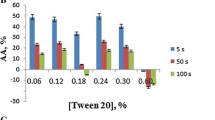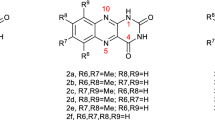Abstract
Photoactivated riboflavin in the presence of Cu(II) generates reactive oxygen species (ROS) which can hemolyze human red blood cells (RBC). In the present work we examined the effect of sodium azide (NaN3) on RBC in the presence of riboflavin and Cu(II). The addition of NaN3 to the riboflavin-Cu(II) system enhanced K+ loss and hemolysis. The extent of K+ loss and hemolysis were time and concentration dependent. Bathocuproine, a Cu(I)-sequestering agent, inhibited the hemolysis completely. Among various free radical scavengers used to identify the major ROS involved in the reaction, thiourea was found to be the most effective scavenger. Thiourea caused almost 85%inhibition of hemolysis suggesting that ·OH is the major ROS involved in the reaction. Using spectral studies and other observations, we propose that when NaN3 is added to the riboflavin-Cu(II) system, it inhibits the photodegradation of riboflavin resulting in increased ·OH generation. Also, the possibility of azide radical formation and its involvement in the reaction could not be ruled out.
Similar content being viewed by others
Abbreviations
- ROS:
-
reactive oxygen species
- RBC:
-
red blood cells
REFERENCES
Halliwell, B., and Gutteridge, J. M.C. (1985) Free Radicals in Biology and Medicine, Clarendon Press, Oxford.
George-Hyslop, P. H. (2000) Sci. Am., 283, 76–83.
Halliwell, B. (1987) FASEB J., 1, 358–364.
Babior, B. M. (1978) New Eng. J. Med., 298, 259–268.
Miller, R. A., and Britigan, B. E. (1995) J. Invest. Med., 43, 39–49.
Naseem, I., Ahmad, M., Bhat, R., and Hadi, S. M. (1993) Fd. Chem. Toxicol., 31, 589–597.
Jazzar, M., and Naseem, I. (1994) Biochem. Mol. Biol. Int., 34, 883–895.
Ali, I., Ghatasheh, M. K. M., and Naseem, I. (2000) Biochim. Biophys. Acta, 1523, 225–229.
Naseem, I., Ahmad, M., and Hadi, S. M. (1988) Biosci. Rep., 8, 485–492.
Jazzar, M. M., and Naseem, I. (1996) Free Rad. Biol. Med., 21, 7–14.
Andley, U. P., and Clark, B. A. (1988) Exp. Eye Res., 47, 1–15.
Jedziniak, J., Arredondo, M., and Andley, U. P. (1987) Curr. Eye Res., 6, 345–350.
Silvia, E. (1979) Rad. Env. Biophys., 16, 71–79.
Suzuki, Y., Miura, T., and Ogiso, T. (1982) J. Pharm. Dyn., 5, 568–575.
Andley, U. P., and Clark, B. A. (1988) Curr. Eye Res., 7, 571–579.
Knoblock, E., Mandys, F., and Hodr, R. (1988) J. Chrom., 428, 255–263.
Newburger, J., Combs, A. B., and Hsu, T. F. (1977) J. Pharm. Sci., 66, 1561–1564.
Bhatia, J., and Rassin, D. K. (1985) J. Parent. Nutr., 9, 491–495.
Frissell, W. R., Chung, C. W., and Mackenzie, C. G. (1956) J. Biol. Chem., 234, 1297–1302.
Tabatabaie, T., and Floyd, R. A. (1994) Arch. Biochem. Biophys., 314, 112–119.
Clemens, M. R., and Waller, H. D. (1987) Chem. Phys. Lipids, 45, 251–268.
Hoebeke, M., Schiuntmaker, H. J., Jannink, L. E., Dubbelman, T. M. A. R., Jakobs, A., and Vorst, A. V. D. (1997) Photochem. Photobiol., 66, 502–508.
Behrman, R. E., Brown, A. K., Currie, M. R., Hastings, J. W., Odell, G. B., Schaffer, R., Setlow, R. B., Vogl, T. B., Wurtman, R. J., Anderson, H. J., Kostowzki, H. J., and Simopoulos, A. P. (1974) J. Pediatr., 84, 135–s137.
Ali, S. M., and Olivo, M. (2003) Int. J. Oncol., 22, 751–756.
Yoshida, Y., Kashiba, K., and Niki, E. (1994) Biochim. Biophys. Acta, 1201, 165–172.
Frati, E., Khatib, A. M., Front, P., Panasyuk, A., Aprile, F., and Mitrovic, D. R. (1997) Free Rad. Biol. Med., 22, 1139–1144.
Yokochi, N., Morita, T., and Yagi, T. (2003) J. Agr. Fd. Chem., 23, 2733–2736.
Patridge, R. S., Monroe, S. M., Parks, J. K., Johnson, K., Parker, W. D., Eaton, G. R., and Eaton, S. S. (1994) Arch. Biochem. Biophys., 310, 210–217.
Zhao, R., Lind, J., Merenyl, G., and Eriksen, T. E. (1994) J. Am. Chem. Soc., 116, 12010–12015.
Forni, L. G., and Willson, R. L. (1986) Biochem. J., 240, 897–903.
Alfassi, Z. B. (1985) J. Phys. Chem., 89, 3359–3363.
Author information
Authors and Affiliations
Corresponding author
Additional information
__________
Translated from Biokhimiya, Vol. 70, No. 9, 2005, pp. 1226–1230.
Original Russian Text Copyright © 2005 by Ali, Sakhnini, Naseem.
Originally published in Biochemistry (Moscow) On-Line Papers in Press, as Manuscript BM04-240, December 26, 2004.
Rights and permissions
About this article
Cite this article
Ali, I., Sakhnini, N. & Naseem, I. Hemolysis of Human Red Blood Cells by Riboflavin-Cu(II) System: Enhancement by Azide. Biochemistry (Moscow) 70, 1011–1014 (2005). https://doi.org/10.1007/s10541-005-0217-x
Received:
Revised:
Issue Date:
DOI: https://doi.org/10.1007/s10541-005-0217-x




